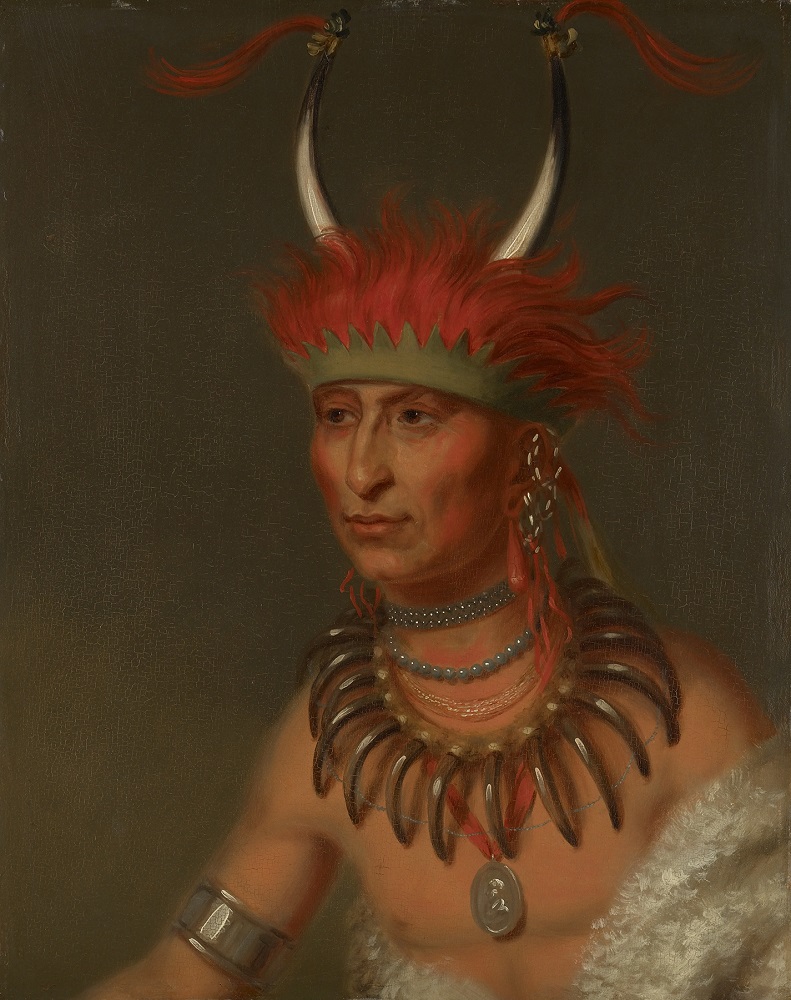
Charles Bird King (1785-1862)
Ottoe Half Chief, Husband of Eagle of Delight
ca. 1821-1822
Oil on panel
Crystal Bridges Museum of American Art, Bentonville, AR
While portraiture may seem to imitate life, throughout history it has also served to influence life and affect public perception. Today, September 26, we celebrate the birthday of Charles Bird King, whose portraits of American Indians serve not just as a priceless artifacts of the past, but also helped to favorably color public opinion of a controversial public policy: that of the Indian delegations of 1821 to 1842.
To avoid war with powerful tribes, the young United States had made a practice of inviting influential Native American leaders to major cities, especially Washington DC. Delegates came for various reasons: to represent the concerns of their tribes or negotiate treaties, as well as to satisfy their own curiosity. They met with the US president, received official gifts, and toured military bases. In effect, these leaders were both cajoled and coerced in an attempt to gain their cooperation in the expansion of the United States. Delegates negotiating a treaty might stay as long as six months, and new groups of delegates arrived almost weekly. Superintendent of Indian Trade Charles McKenney, or “The Colonel” as he preferred, was a key figure in Indian affairs during the early 1800s, and quickly realized the importance of documenting the Native American peoples. McKenney founded Washington’s first museum, which he called “The Archives of the American Indian.” To add portraits to his museum, he turned to romantic painter and newly arrived resident of Washington DC, Charles Bird King.

Detail of a self-portrait by Charles Bird King.
Charles Bird King was born in Newport, Maine, and studied first under Edward Savage, then Benjamin West. He was a part of the Romantic Movement, which espoused imagination, emotion, and freedom. Having experienced early success with his still lifes, such as The Poor Artist’s Cupboard (c.1815), (now in the collection of the National Gallery of Art), he moved to Washington DC in 1819 to enjoy the possibilities the burgeoning city promised. He quickly developed strong patronage, and in 1921 was commissioned by the federal government, at the behest of McKenney, to paint portraits of the Indian delegates. Over the next 20 years he had painted at least 143 portraits.
Contrary to the opinion, held by many US citizens, of Native Americans as a terrifying threat, Romanticism idealized American Indians as “noble savages,” heroic champions of a simpler time. Charles Bird King’s portraits typified this perspective. In their traditional garments and often decorated with the coveted presidential peace medal around their necks, the Native leaders King depicted were as dignified and stately as classical Roman statues. Indeed, many Romantics connected what they saw as the vanishing American Indian way of life with the lost race of classical heroes such as Jason and Homer. Unfortunately, this idealization did little to aid the American Indians, who were eventually pushed to the brink of extinction by disease, forced relocation, and poverty.
Additional blog posts about works by Charles Bird King in Crystal Bridges’ permanent collection can be found here.
To learn more about this important American artist, visit the Crystal Bridges Library to read The Indian Legacy of Charles Bird King, by Herman J. Viola.



